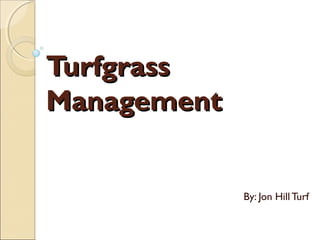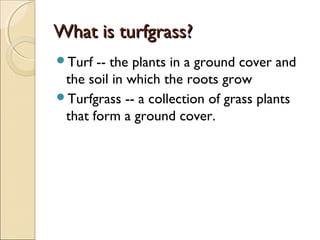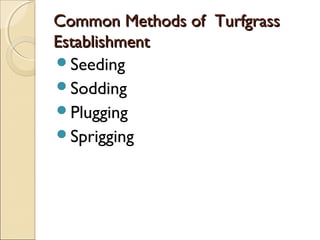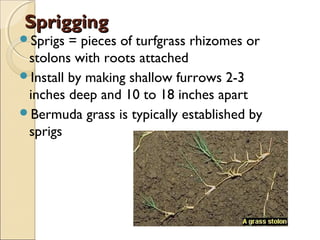Jon Hill Turf | What is Turf Grass and its Management
- 2. What is turfgrass?What is turfgrass? ’éŚTurf -- the plants in a ground cover and the soil in which the roots grow ’éŚTurfgrass -- a collection of grass plants that form a ground cover.
- 3. Uses of TurfgrassUses of Turfgrass ’éŚOrnamental ’éŚUtility ’éŚAthletic
- 4. Benefits of TurfgrassBenefits of Turfgrass ’éŚIncrease property value ’éŚControl erosion ’éŚCooling effect/clean air ’éŚReduces player injuries
- 5. Types of TurfgrassesTypes of Turfgrasses ’éŚCool-season grasses ŌŚ” grow best in a temperature range of 60-75. ’éŚWarm-season grasses ŌŚ” grow best in a temperature range of 80-95.
- 7. Warm Season GrassesWarm Season Grasses ’éŚBahiagrass ’éŚBermuda grass ’éŚCarpetgrass ’éŚCentipedegrass ’éŚSt. Augustinegrass ’éŚZoysia
- 8. Cool Season GrassesCool Season Grasses ’éŚBuffalograss ’éŚBentgrass ’éŚFescue ’éŚKentucky Bluegrass ’éŚPerennial Ryegrass
- 9. Establishing TurfgrassEstablishing Turfgrass Which way is the BEST way?
- 10. Common Methods of TurfgrassCommon Methods of Turfgrass EstablishmentEstablishment ’éŚSeeding ’éŚSodding ’éŚPlugging ’éŚSprigging
- 11. Turfgrass Establishment ByTurfgrass Establishment By SEEDSEED
- 12. Advantages:Advantages: ’éŚDesired species or cultivars can be used ’éŚThe plants develop in the environment in which they must ultimately survive ’éŚThis method is LESS EXPENSIVE
- 13. Factors for Good Seed GerminationFactors for Good Seed Germination & Growth& Growth ’éŚLive seedŌĆ”donŌĆÖt buy cheap seed ’éŚAdequate moisture ’éŚSufficient soil warmth ’éŚAdequate soil aeration
- 14. Steps in Seeding aSteps in Seeding a New LawnNew Lawn
- 15. #1. Site Preparation#1. Site Preparation ’éŚRough Grade; remove rocks and wood ’éŚApply herbicide to kill existing weeds ’éŚConduct a soil test ’éŚApply soil amendments as necessary ’éŚThoroughly mix amendments to a depth of 6ŌĆØ ’éŚFinish grade the site
- 17. #2. Seed Selection#2. Seed Selection ’éŚSelect disease resistant varieties ’éŚMay be one single cultivar or a blend ’éŚBuy certified seed
- 18. # 3. Planting# 3. Planting ’éŚRead the Seed Label for application rate ŌŚ” Tall fescue: 7-9 lb/1000 sq ft. ŌŚ” Kentucky Bluegrass: 2-3 lb/1000 sq. ft. ’éŚSow Seed Uniformly ŌŚ” sow with a broadcast spreader ŌŚ” sow 1/2 in one direction; sow other half at 90 degree angles ŌŚ” Avoid sowing too thickly
- 20. ’éŚAssure good seed to soil contact ŌŚ” Use a rake to lightly mix seed into top 1/4ŌĆØ of soil ŌŚ” Roll lightly ’éŚApply a thin layer of straw ’éŚMake sure adequate water is available ŌŚ” Water frequently and lightly ŌŚ” Important for root development
- 22. Turfgrass Establishment ByTurfgrass Establishment By Vegetative PropagationVegetative Propagation Sodding, Plugging, Sprigging
- 23. SoddingSodding ’éŚProvides an instant lawn ’éŚIncludes grass plants and a thin layer of soil ’éŚSod is harvested in rolls
- 24. Things to RememberThings to Remember ’éŚSod is usually 18ŌĆØ wide, 6ŌĆÖ long, 5/8ŌĆØ thick ’éŚComes in rolls or stacks ’éŚBuy high quality = dense and free of weeds ’éŚShould be installed 24 hours after cutting ’éŚSteps in site prep same for seeding
- 26. Steps in Laying SodSteps in Laying Sod ’éŚPrepare site ’éŚDampen planting area ’éŚPosition 1st piece along a straight edge ’éŚLay rolls in parallel manner, staggering the ends ’éŚAdequate irrigation is a must
- 27. PluggingPlugging ’éŚPlug = a small, 2-4 inch square or circular piece of sod ’éŚMainly used to establish sub-tropical grasses ’éŚPlant plugs 6-8 inches apart ’éŚFirm soil around plugsŌĆ”maintain moisture
- 28. SpriggingSprigging ’éŚSprigs = pieces of turfgrass rhizomes or stolons with roots attached ’éŚInstall by making shallow furrows 2-3 inches deep and 10 to 18 inches apart ’éŚBermuda grass is typically established by sprigs





























